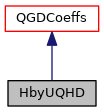Class for one of possible ways of $$ calculating. in this case $$ parameter is calculating by.
More...
|
| | TypeName ("HbyUQHD") |
| |
| | HbyUQHD (const IOobject &io, const fvMesh &mesh, const dictionary &dict) |
| |
| | ~HbyUQHD () |
| |
| void | correct (const QGDThermo &) |
| |
| | TypeName ("QGDCoeffs") |
| |
| | declareRunTimeSelectionTable (autoPtr, QGDCoeffs, dictionary,(const IOobject &io, const fvMesh &mesh, const dictionary &dict),(io, mesh, dict)) |
| |
| | QGDCoeffs (const IOobject &io, const fvMesh &mesh, const dictionary &dict) |
| | Construct from components. More...
|
| |
| virtual | ~QGDCoeffs () |
| |
| virtual bool | writeData (Ostream &) const |
| |
| const volScalarField & | hQGD () const |
| |
| const volScalarField & | tauQGD () const |
| |
| const surfaceScalarField & | hQGDf () const |
| |
| const surfaceScalarField & | tauQGDf () const |
| |
| const volScalarField & | muQGD () const |
| |
| const volScalarField & | alphauQGD () const |
| |
Class for one of possible ways of $$ calculating. in this case $$ parameter is calculating by.
$$ = {h}{U_0} $$
Where:
$$ is regularisation parameter, $$ is parameter which depends by user in constant foulder, $h$ is size of the mesh and $U_0$ is characteristic velocity
- Source files
-
Definition at line 57 of file HbyUQHD.H.


 Public Member Functions inherited from QGDCoeffs
Public Member Functions inherited from QGDCoeffs Static Public Member Functions inherited from QGDCoeffs
Static Public Member Functions inherited from QGDCoeffs Protected Member Functions inherited from QGDCoeffs
Protected Member Functions inherited from QGDCoeffs Protected Attributes inherited from QGDCoeffs
Protected Attributes inherited from QGDCoeffs